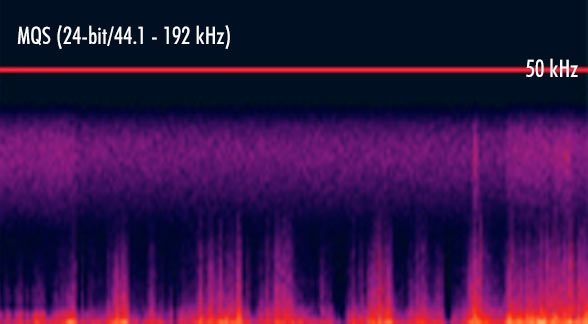MQS – Mastering Quality Sound
According to the Astell & Kern website, “Mastering Quality Sound (MQS) is an acronym of collective lossless & high-resolution audio source formats, typically in 24-bit/44[sic] to 192kHz of bit/sampling rates. Because MQS delivers about 6.5 times more detail than a conventional CD format (16bit/44.1kHz), listeners can enjoy a better and a more realistic sound quality.” Here’s yet another acronym and another blurb that misses the whole point of HD-Audio.
That last sentence is of special interest. What does it mean to say “…listeners can enjoy a better and a more realistic sound quality”? Better than what? Better than a compact disc because it’s capable of “6.5 times more detail than a conventional CD”? Let me see if I can figure out the math. Take the native sampling rate of a Redbook CD at 44.1 kHz (not 44 as stated in their first paragraph) and multiple it by 16 bits for each digital word. The result is 705,600. Then take the maximum sample rate of 192 kHz and multiple that by 24-bits and you get 4,608,000, which is 6.53…very close to their rounded 6.5 times number.
It’s going to be more “more realistic” because there are more bits at a higher sampling rate. There will be “more detail” because there are more bits at a higher sampling rate. No, there won’t. The sound of the original recording will be exactly the same fidelity…great or not…when it’s converted to a digital PCM file at 44.1/16-bits or 192 kHz/24-bits. The only way to take advantage of these specifications is to use equipment running at those specs at the time of the sessions…when the musicians were playing and singing! Taking an analog recording done in the 1960s and transferring it to a 192 kHz/24-bit PCM file or even a DSD 128 (pick your favorite power of 2 here) WILL NOT provide you with any additional sonic information. The process of transferring the original source into the bigger bit bucket might sound different because of other factors and going to DSD at any power will increase the ultrasonic noise level, but the signal to noise ratio and dynamic range of the source will remain the same.
They include a few spectragraphs of some music at MP3 (128 kbps/44.1 kHz), .WAV (16-bit/48 kHz) and finally an MQS file at (24-bits/44[sic] – 192 kHz). I copied the MQS spectragraph below:

Figure 1 – A spectragraph that is supposed to show an MQS (Mastering Quality Sound) file. Notice the “purple haze” cloud of noise above 22 kHz.
This “MQS” quality diagram is not encouraging at all. Do you really want your headphones or playback system to try and reproduce that large noise component? Do you really want your ears to experience a non-correlated cloud of shifted noise? I don’t think so. I can imagine when having the extended playback capabilities of their player would come in handy but only if the source files have legitimate content that could benefit from the higher specs.
So what we’re seeing is another instance of a company using big numbers to market their products with vague and meaningless acronyms and dubious claims that compare irrelevant bit counts.
There are others that are pushing “Studio Quality Sound”. Maybe it’s the same thing as MQS, I honestly don’t know. But what’s important is to know the capabilities of a particular format and then match it with the maximum specifications of the music you’re trying to capture. If an analog tape has 60 dB of SNR (Signal to Noise Ratio) and a frequency range of 20 kHz, then a well-made compact disc could capture it. I have no argument with people using bigger bit buckets (after all they are cheap these days) but it’s usually overkill. The Astell & Kern player might have the potential of reproducing better than CD quality, but not unless the music was recorded with high definition in mind.


Well, I’m certainly enlightened by the article. You know I was raised in the sciences, and have gained a very rational, skeptical mind. I’m gonna have to spread this article where it counts, along with a good reality slap.
this just isnt true. led zeppelin master studio tapes, for example, sound better at 24 bit and high sampling rates compared to how they sound on a 16/44 CD. the bass is more accurate, and the average person can hear the difference in quality. The better quality isn’t created by the modern equipment; it was always there in the master tapes.